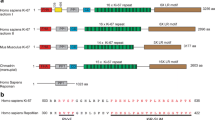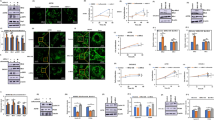Abstract
The aim of this study was to identify protein kinases (PKs) involved in the expression of proliferating cell nuclear antigen (PCNA) and p53, markers of proliferation and apoptosis in human ovarian cells. Cultured ovarian granulosa cells were subjected to transfection with 264 small-interfering RNA (siRNA) constructs from a siRNA library, which selectively blocked the expression of 88 known PKs. The efficiency of transfection and siRNA knockdown were validated by fluorescent microscopy, real-time reverse transcription polymerase chain reaction, and immunocytochemical analysis. The expression of PCNA and p53, before and after transfection with siRNA constructs, was evaluated by immunocytochemistry. The siRNA constructs suppressed the expression of their targets molecules by up to 84%. Knockdown of 32 of the 88 PKs inhibited the expression of PCNA, while the knockdown of seven of the PKs stimulated PCNA expression. Knockdown of 30 of the 88 PKs reduced the expression of p53, while knockdown of five PKs enhanced p53 expression. Our results illustrate that siRNA constructs are useful tools for understanding the role of PKs in the control of ovarian cell functions, such as proliferation and apoptosis. The specific knockdown of individual PKs has enabled the identification of a number of new PKs that control the expression of PCNA and p53 in human ovarian cells.






Similar content being viewed by others
References
Amsterdam A, Sasson R, Keren-Tal I, Aharoni D, Dantes A, Rimon E, Land A, Cohen T, Dor Y, Hirsh L (2003a) Alternative pathways of ovarian apoptosis: death for life. Biochem Pharmacol 66:1355–1362
Amsterdam A, Keren-Tal I, Aharoni D, Dantes A, Land-Bracha A, Rimon E, Sasson R, Hirsh L (2003b) Steroidogenesis and apoptosis in the mammalian ovary. Steroids 68:861–867
Berisha B, Schams D (2005) Ovarian function in ruminants. Domest Anim Endocrinol 29:305–317
Braithwaite AW, Del Sal G, Lu X (2006) Some p53-binding proteins that can function as arbiters of life and death. Cell Death Differ 13:984–993
Brown L, Boswell S, Raj L, Lee SW (2007) Transcriptional targets of p53 that regulate cellular proliferation. Crit Rev Eukaryot Gene Expr 17:73–85
Chaffin CL, Brogan RS, Stouffer RL, VandeVoort CA (2003) Dynamics of Myc/Max/Mad expression during luteinization of primate granulosa cells in vitro: association with periovulatory proliferation. Endocrinology 144:1249–1256
Cherian-Shaw M, Das R, Vandevoort CA, Chaffin CL (2004) Regulation of steroidogenesis by p53 in macaque granulosa cells and H295R human adrenocortical cells. Endocrinology 145:5734–5744
Chowdhury I, Tharakan B, Bhat GK (2006) Current concepts in apoptosis: The physiological suicide program revisited. Cell Mol Biol Lett 11:506–525
Crijns AP, Duiker EW, de Jong S, Willemse PH, van der Zee AG, de Vries EG (2006) Molecular prognostic markers in ovarian cancer: toward patient-tailored therapy. Int J Gynecol Cancer Suppl 1:152–165
Fortune JE, Cushman RA, Wahl CM, Kito S (2000) The primordial to primary follicle transition. Mol Cell Endocrinol 163:53–60
Gray D, Jubb AM, Hogue D, Dowd P, Kljavin N, Yi S, Bai W, Frantz G, Zhang Z, Koeppen H, de Sauvage FJ, Davis DP (2005) Maternal embryonic leucine zipper kinase/murine protein serine-threonine kinase 38 is a promising therapeutic target for multiple cancers. Cancer Res 65:9751–9761
Herr D, Keck C, Tempfer C, Pietrowski D (2004) Chorionic gonadotropin regulates the transcript level of VHL, p53, and HIF-2alpha in human granulosa lutein cells. Mol Reprod Dev 69:397–401
Hunzicker-Dunn M, Maizels ET (2006) FSH signaling pathways in immature granulosa cells that regulate target gene expression: branching out from protein kinase A. Cell Signal 18:1351–1359
Hussein MR, Bedaiwy MA, Falcone T (2006) Analysis of apoptotic cell death, Bcl-2, and p53 protein expression in freshly fixed and cryopreserved ovarian tissue after exposure to warm ischemia. Fertil Steril 85(Suppl 1):1082–1092
Hutt KJ, McLaughlin EA, Holland MK (2006) Primordial follicle activation and follicular development in the juvenile rabbit ovary. Cell Tissue Res 326:809–822
Jiang JY, Cheung CK, Wang Y, Tsang BK (2003) Regulation of cell death and cell survival gene expression during ovaria follicular development and atresia. Front Biosci 8:222–237
Kelloff GJ, Boone CW, Crowell JA, Nayfield SG, Hawk E, Steele VE, Lubet RA, Sigman CC (1995) Strategies for phase II cancer chemoprevention trials: cervix, endometrium, and ovary. J Cell Biochem Suppl 23:1–9
Kumar SR, Masood R, Spannuth WA, Singh J, Scehnet J, Kleiber G, Jennings N, Deavers M, Krasnoperov V, Dubeau L, Weaver FA, Sood AK, Gill PS (2007) The receptor tyrosine kinase EphB4 is overexpressed in ovarian cancer, provides survival signals and predicts poor outcome. Br J Cancer 96:1083–1091
Lane D, Robert V, Grondin R, Rancourt C, Piché A (2007) Malignant ascites protect against TRAIL-induced apoptosis by activating tle PI3K/Akt pathway in human ovarian carcinoma cells. Int J Cancer 121:1227–1237
Livneh Z (2006) Keeping mammalian mutation load in check: regulation of the activity of error-prone DNA polymerases by p53 and p21. Cell Cycle 5:1918–1922
Ma Y, Yu WD, Kong RX, Trump DL, Johnson CS (2006) Role of nongenomic activation of phosphatidylinositol 3-kinase/Akt and mitogen-activated protein kinase/extracellular signal-regulated dinase kinase/extracellular signal-regulated kinase 1/2 pathways in 1,25D3-mediated apoptosis in squamous cell carcinoma cells. Cancer Res 66:8131–8138
Maga G, Hubscher U (2003) Proliferating cell nuclear antigen (PCNA): a dancer with many partners. J Cell Sci 116:3051–3060
Makarevich A, Sirotkin A, Chrenek P, Bulla J, Hetenyi L (2000) The role of IGF-I, cAMP/protein kinase A and MAP-kinase in the control of steroid secretion, cyclic nucleotide production, granulosa cell proliferation and preimplantation embryo development in rabbits. J Steroid Biochem Mol Biol 73:123–133
Makarevich AV, Sirotkin AV, Chrenek P, Bulla J (2002) Effect of epidermal growth factor (EGF) on steroid and cyclic nukleotide secretion, proliferation and ERK-related MAP-kinase in cultured rabbit granulosa cells. Exp Clin Endocrinol Diabetes 110:124–129
Makarevich AV, Sirotkin AV, Genieser HG (2004a) Action of protein kinase A regulators on secretory activity of porcine granulosa cells in vitro. Anim Reprod Sci 81:125–136
Makarevich AV, Sirotkin AV, Franek J, Kwon HB, Bulla J (2004b) The role of oxytocin, protein kinase A, and ERK-related MAP-kinase in the kontrol of porcine ovarian follicle functions. Exp Clin Endocrinol Diabetes 112:108–114
Marchetti A, Cecchinelli B, D Angelo M, D Orazi G, Crescenzi M, Sacchi A, Soddu S (2004) p53 can inhibit cell proliferation through caspase-mediated cleavage of ERK2/MAPK. Cell Death Differ 11:596–607
Martin L, Schilder RJ (2006) Novel non-cytotoxic therapy in ovarian cancer: current status and future prospects. J Natl Compr Canc Netw 4:955–966
McHugh PJ, Sarkar S (2006) DNA interstrand cross-link repair in the cell cycle: a critical role for polymerase zeta in G1 phase. Cell Cycle 5:1044–1047
Mészárosová M, Sirotkin AV, Grossmann R, Darlak K, Valenzuela F (2008) The effect of obestatin on porcine ovarian granulosa cells. Anim Reprod Sci 108:196–207
Moldovan GL, Pfander B, Jentsch S (2007) PCNA, the maestro of the replication fork. Cell 129:665–679
Nam EJ, Kim YT (2008) Alteration of cell-cycle regulation in epithelial ovarian cancer. Int J Gynecol Cancer (in press)
Noske A, Kaszubiak A, Weichert W, Sers C, Niesporek S, Koch I, Schaefer B, Sehouli J, Dietel M, Lage H, Denkert C (2007) Specific inhibition of AKT2 by RNA interference results in reduction of ovaria cancer cell proliferation: increased expression of AKT in advanced ovaria cancer. Cancer Lett 246:190–200
Osborn M, Isenberg S (1994) Immunocytochemistry of frozen and paraffin tissue sections. In: Celis JE (ed) Cell biology. A laboratory handbook, vol. 2. Academic, New York, pp 361–367
Ovcharenko D, Kelnar K, Johnson C, Leng N, Brown D (2007) Genome-scale microRNA and small interfering RNA screens identify small RNA modulators of TRAIL-induced apoptosis pathway. Cancer Res 67:10782–10788
Peluso JJ (2006) Multiplicity of progesterone’s actions and receptors in the mammalian ovary. Biol Reprod 75:2–8
Richards JS, Russell DL, Ochsner S, Hsieh M, Doyle KH, Falender AE, Lo YK, Sharma SC (2002) Novel signaling pathways that control ovarian follicular development, ovulation, and luteinization. Recent Prog Horm Res 57:195–220
Sawada K, Radjabi AR, Shinomiya N, Kistner E, Kenny H, Becker AR, Turkyilmaz MA, Salgia R, Yamada SD, Vande Woude GF, Tretiakova MS, Lengyel E (2007) c-Met overexpression is a prognostic factor in ovarian cancer and an effective target for inhibition of peritoneal dissemination and invasion. Cancer Res 67:1670–1679
Shimada M, Zeng WX, Terada T (2001) Inhibition of phosphatidylinositol 3-kinase or mitogen-activated protein dinase kinase leads to suppression of p34(cdc2) kinase activity and meiotic progression beyond the meiosis I stage in porcine oocytes surrounded with cumulus cells. Biol Reprod 65:442–448
Sirotkin AV (2005) Control of reproductive processes by growth hormone: extra- and intracellular mechanisms. Vet J 170:307–317
Sirotkin AV, Grossmann R (2003) Role of tyrosine kinase- and MAP kinase-dependent intracellular mechanisms in control of ovarian functions in the domestic fowl (Gallus domesticus) and in mediating effects of IGF-II. J Reprod Dev 49:99–106
Sirotkin AV, Grossmann R (2006) The role of protein kinase A and cyclin-dependent (CDC2) kinase in the control of basal and IGF-II-induced proliferation and secretory activity of chicken ovarian cells. Anim Reprod Sci 92:169–181
Sirotkin AV, Grossmann R (2007a) Leptin directly controls proliferation, apoptosis and secretory activity of cultured chicken ovarian cells. Comp Biochem Physiol A Mol Integr Physiol 148:422–429
Sirotkin AV, Grossmann R (2007b) The involvement of leptin, MAP kinase- and CDC2 kinase-dependent intracellular mechanisms in the control of hormone release by chicken ovarian granulosa cells. Slov J Anim Sci 41:6–11
Sirotkin AV, Grossmann R (2007c) The role of ghrelin and some intracellular mechanisms in controlling tle secretory activity of chicken ovarian cells. Comp Biochem Physiol A Mol Integr Physiol 147:239–246
Sirotkin AV, Makarevich AV (2002) Growth hormone can regulate functions of porcine ovarian granulosa cells through the cAMP/protein kinase A system. Anim Reprod Sci 70:111–126
Sirotkin AV, Makarevich AV, Pivko J, Kotwica J, Genieser H, Bulla J (2000a) Effect of cGMP analogues and protein kinase G blocker on secretory activity, apoptosis and the cAMP/protein kinase A system in porcine ovarian granulosa cells in vitro. J Steroid Biochem Mol Biol 74:1–9
Sirotkin AV, Dukesová J, Makarevich AV, Kubek A, Bulla J (2000b) Evidence that growth factors IGF-I, IGF-II and EGF can stimulate nuclear maturation of porcine oocytes via intracellular protein kinase A. Reprod Nutr Dev 40:559–569
Sirotkin AV, Grossmann R, María-Peon MT, Roa J, Tena-Sempere M, Klein S (2006) Novel expression and functional role of ghrelin in chicken ovary. Mol Cell Endocrinol 257–258:15–25
Sirotkin AV, Mlynček M, Makarevich AV, Florkovičová I, Hetényi L (2008) Leptin affects proliferation-, apoptosis- and protein kinase A-related peptides in human ovarian granulosa cells. Physiol Res 57:437–442
Stouffer RL, Xu F, Duffy DM (2007) Molecular control of ovulation and luteinization in the primate follicle. Front Biosci 12:297–307
Suga S, Kato K, Ohgami T, Yamayoshi A, Adachi S, Asanoma K, Yamaguchi S, Arima T, Kinoshita K, Wake N (2007) An inhibitory effect on cell proliferation by blockage of the MAPK/estrogen receptor/MDM2 signal pathway in gynecologic cancer. Gynecol Oncol 105:341–350
Tamura M, Nakagawa Y, Shimizu H, Yamada N, Miyano T, Miyazaki H (2004) Cellular functions of mitogen-activated protein kinases and protein tyroxine phosphatases in ovarian granulosa cells. J Reprod Dev 50:47–55
Xu G, Zhou H, Wang Q, Auersperg N, Peng C (2006) Activin receptor-like kinase 7 induces apoptosis through up-regulation of Bax and down-regulation of Xiap in normal and malignant ovarian epithelial cell lines. Mol Cancer Res 4:235–246
Zeng P, Wagoner HA, Pescovitz OH, Steinmetz R (2005) RNA interference (RNAi) for extracellular signal-regulated kinase 1 (ERK1) alone is sufficient to suppress cell viability in ovarian cancer cells. Cancer Biol Ther 4:961–967
Acknowledgments
The authors express their deepest gratitude to Ing. Ž. Kuklová and Mrs. K. Tothová for skillful technical assistance.
Author information
Authors and Affiliations
Corresponding author
Rights and permissions
About this article
Cite this article
Sirotkin, A.V., Ovcharenko, D., Benčo, A. et al. Protein kinases controlling PCNA and p53 expression in human ovarian cells. Funct Integr Genomics 9, 185–195 (2009). https://doi.org/10.1007/s10142-008-0102-y
Received:
Revised:
Accepted:
Published:
Issue Date:
DOI: https://doi.org/10.1007/s10142-008-0102-y




